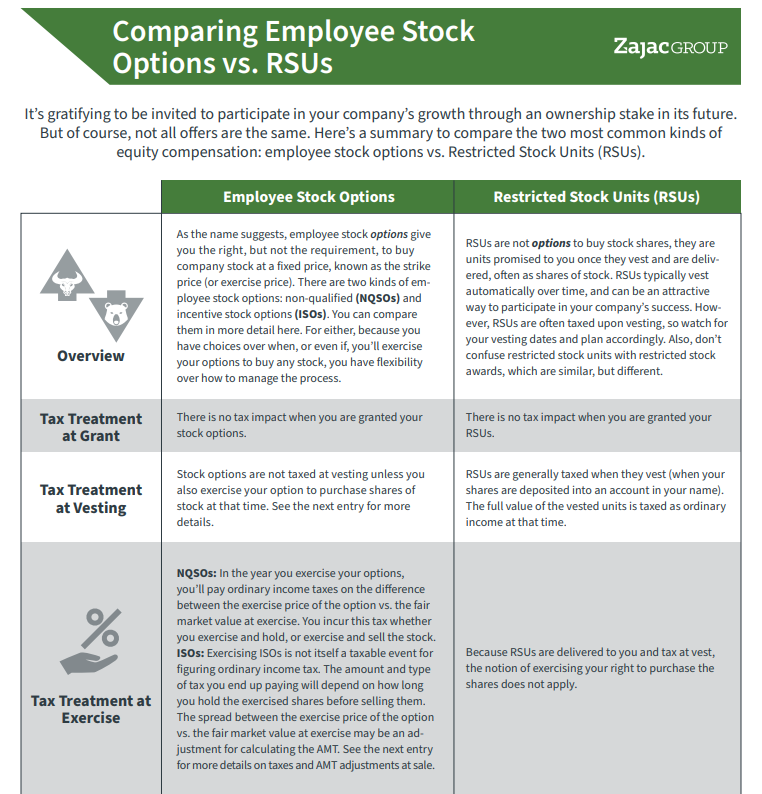Restricted stock is often considered the simplest type of equity compensation to understand. And relative to other types of equity you could receive, this might be true. But that doesn’t mean managing restricted stock is easy.
Restricted stock gets complicated thanks to factors such as double triggers, tax withholding (or lack thereof), and sell-to-cover or cashless exercises. The complexity further increases when you need to fit your decisions around your restricted stock into context with the income tax impacts, other types of equity compensation you might have, your financial plan, and the overall investment risks you take.
Fortunately, complexity can present opportunities if you’re informed and willing to do the proper planning. Here are some advanced planning considerations that become particularly relevant in years when your restricted stock vests.
1. Coordinate Your Incentive Stock Option Strategy with Vesting Years for Restricted Stock
If you have both restricted stock and incentive stock options (or ISOs), you need to pay close attention to the strategy you use to manage your ISOs in the years your restricted stock vests.
When restricted stock units vest, the value is considered taxable income. That can impact the calculations for the alternative minimum tax (AMT), and subsequently how many incentive stock options you may be able to exercise and hold and without paying AMT.
Let’s assume the following to illustrate this point:
COMPARISON GUIDE
Not All Stock Offers are the Same! Here's a helpful comparison between two of the most common employee stock options.
- A married couple files taxes as Married Filing Jointly
- They have a base income of $250,000
- They have 1,500 RSUs that will vest this year at a price of $140 per share
- They also have 1,000 ISOs with a strike price of $5
Using these facts, we can estimate the following tax calculations:
| Taxes Owed on Base Salary Only | Taxes on Base Salary + RSUs | |
| Regular Income Tax | $42,000 | $101,000 |
| Tentative Minimum tax | $35,000 | $92,000 |
| Delta | $7,000 | $9,000 |
The difference between the regular tax due and the tentative minimum tax is $7,000 when only looking at the couple’s base salary. But when the vested RSUs are factored in, the delta is $9,000 – or a $2,000 difference.
That difference is the information you can use to determine how many ISOs you can exercise and hold prior to incurring AMT.
Let’s assume a flat AMT tax rate of 28%. We can calculate how much bargain element to exercise and hold so that the tentative minimum tax equals the regular tax. In this example, that math is as follows:
Bargain Element = Delta / Assumed Tax Rate
= $7,000 / .28
= $25,000 (rounded)
We can then determine how many ISOs can be exercised and held to create $25,000 worth of bargain element:
ISO Exercised and Held = Target Bargain Element / (FMV Stock – Strike Price)
= $25,000 / (140 -5)
= 185
If we now factor the vested RSUs into the equation, we can determine this couple could accrue approximately $32,000 worth of bargain element. In this example, that’s 237 incentive stock options.
| Base Salary Only | Base Salary + RSU | |
| Regular Tax | $42,000 | $101,000 |
| Tentative Minimum tax | $35,000 | $92,000 |
| Delta | $7,000 | $9,000 |
| At 28% Tax | $25,000 | $32,142 |
| ISO Exercised and Held | 185 | 237 |
As the amount of taxable income generated from vesting RSUs increases, the spread between regular tax and tentative minimum tax typically, but not always, rises as well. In scenarios when this is true it, means more ISOs can be exercised and held if your income increases because of vested RSUs.
If you have a year with substantially higher total income due to vested restricted stock, the opportunity to exercise and hold ISOs might be too significant to pass up.
To illustrate, assume that in lieu of 1,500 RSUs vesting, our married couple has 6,000 RSUs vesting for a total taxable income of $840,000. (This increase in units can often happen in circumstances involving double-trigger units, restricted stock that hits performance metric, or a single large vesting event.)
The increase in taxable income from the vested RSUs means a greater delta between the regular income tax and the tentative minimum tax. And that creates more opportunities to exercise and hold ISOs.
| Base Salary Only | Base Salary + 1,500 Vested RSU | Base Salary + 6,000 Vested RSU | |
| Gross Compensation | $250,000 | $460,0000 | $1,090,000 |
| Regular Income Tax | $42,000 | $101,000 | $330,000 |
| Tentative Minimum tax | $35,000 | $92,000 | $272,000 |
| Delta | $7,000 | $9,000 | $58,000 |
| At 28% Tax | $25,000 | $32,142 | $207,142 |
| ISO Exercised and Held | 185 | 237 | 1,534 |
As this chart illustrates, a higher income due to the value of vested RSUs has a meaningful impact on how many ISOs you may be able to exercise and hold without paying the AMT. This is why it’s critical to review your ISO strategy in years that you have changes in your income due to vesting restricted stock.
2. Review Your Non-Qualified Stock Option Strategy
Incentive stock options are not the only stock option that should be considered in calendar years when restricted stock units vest. You’ll also want to consider your non-qualified stock options strategy.
Generally speaking, non-qualified stock options (NSOs) are taxable as ordinary income the calendar year they are exercised. That’s true regardless of whether you exercise and hold shares or exercise and sell shares. The spread between the strike price of the NSO and the fair market value at exercise is taxed as ordinary income.
One thought to consider when integrating NSOs and restricted stock units into a single plan is to evaluate if you will have substantial changes in taxable income from one year to the next. For example, it’s possible that you might be in a low income tax year today, but expect significantly higher income next year if you have RSUs scheduled to vest at that time.
In that case, it may make sense to exercise your NSOs now while you are in a lower tax bracket.
Continuing our previous example, let’s assume that in the “Base Salary Only” case the marginal tax bracket is 24% and in the “Base Salary + RSU” it is 32%. For each of these scenarios, the next taxable dollar you earn will be taxed at either 24% or 32%.
To illustrate, let’s assume that you wanted to exercise $100,000 worth of NSOs. Assuming $100,000 is taxable, the total tax bill might be as follows:
| Base Salary Only | Base Salary + RSU | |
| NSO Bargain Element | $100,000 | $100,000 |
| Projected tax (24% vs 32%) | ($24,000) | ($32,000) |
| Net-Proceeds | $76,000 | $68,000 |
As you can see, the net proceeds of exercising NSO in a calendar year when you are in a lower tax bracket saves $8,000 of income tax as compared to a higher tax year. With good planning around your restricted stock, it’s possible to plan an exercise and hold in lower-income years and up to certain tax breakpoints.
3. Consider Participating in Non-Qualified Deferred Compensation Plan
A non-qualified deferred compensation plan might be a good idea if you are expecting a high income tax year due to vesting restricted stock. A non-qualified deferred compensation plan (or NQDC) allows you to defer income in the current year, in lieu of taking that income in future years.
By deferring the income, you will not be subject to Federal income tax on those earnings in the deferral year. You are taxed on the money, however, when you take control of it later (and in the meantime, your income remains subject to Social Security and Medicare taxes in the year it’s earned).
As you plan for big income years due to vesting restricted stock, it may make sense to meaningfully contribute to your NQDC plan as a way to better manage your tax obligations.
Let’s assume that your current-year tax rate is 37%, but you plan to be in a 20% income tax bracket once you hit retirement. Let’s further assume that you contribute $100,000 to a NQDC plan in a single calendar year (although this could be implemented for as many years as you would like, or are allowed to by the plan rules).
Here’s what the tax impact could look like:
| Current Year | Retirement Year | |
| NQDC Contribution | $100,000 | $100,000 |
| Tax Savings (37%) | ($37,000) | |
| Tax Due (20%) | $20,000 |
In this example, you saved $37,000 in the year you deferred earned income. In retirement, when you would take ownership of that deferred income, it would be taxed at a much lower rate of 20% (assuming you are indeed in that tax bracket as you thought you would be at retirement). That creates a tax savings of $17,000.
4. Bunch Charitable Contributions in Years Restricted Stock Vests, and Consider a Donor Advised Fund
Calendar years in which you earn higher-than-normal taxable income due to vested restricted stock are also good years to consider your charitable intentions.
Generally speaking, the tax benefit of your charitable contributions is based on your marginal tax bracket. If you are in a 37% tax bracket, you may get more bang for your charitable buck than you would in a 24% tax bracket.
Assuming you have years when significant RSUs vest and the addition of that income pushes you into higher tax brackets, it may make sense to organize your charitable giving strategically into that same year (assuming giving to charities is one of your goals and priorities in the first place).
Let’s assume that you generally make charitable contributions to the tune of $10,000 per year, and that you are in the 24% tax bracket. Over 5 years, you will contribute a total of $50,000 for a tax savings of $12,000:
| Normal Year | Year 1 | Year 2 | Year 3 | Year 4 | Year 5 | Total |
| Contribution | $10,000 | $10,000 | $10,000 | $10,000 | $10,000 | $50,000 |
| Tax Savings (24%) | $2,400 | $2,400 | $2,400 | $2,400 | $2,400 | $12,000 |
But if vesting RSUs would push you into a higher tax bracket for one year, it might make more sense to contribute the total $50,000 in the same calendar year you expect your taxable income to be higher thanks to the vested units:
| High Income Year | Year 1 | Year 2 | Year 3 | Year 4 | Year 5 | Total |
| Contribution | $50,000 | $0 | $0 | $0 | $0 | $50,000 |
| Tax Savings (37%) | $18,500 | $0 | $0 | $0 | $0 | $18,500 |
By bunching contributions into a single year, you could receive a deduction at a higher tax rate which increases your overall tax savings – with the same total contribution to your charitable cause.
In addition to bunching contributions into a single year, it’s important to consider what you are giving to charity. Are you giving cash or are you giving stock?
Many times, low-cost basis stock is the right gift. If you contribute low-cost basis stock to charity, you avoid selling the stock and incurring capital gains. Gifting the actual stock itself lets you obtain the charitable deduction for the full value of the shares (and the charity can sell the stock tax-free once it takes ownership of the asset).
5. Max Out Your 401(k) and HSA
Some of the easier strategies to employ during a high-income tax year are items such as maxing out a 401(k) plan (and exploring after-tax contributions if available within your plan), maxing out an HSA if you’re eligible to contribute, and maxing out allowable contributions to an ESPP if you participate in one.
All of these goals may be easier to accomplish in years that you have more cash flow from vested RSUs.
6. Plan for Income Tax and Stock Liquidation
There are a number of other decisions you’ll need to address if you have vesting RSUs.
For example, what is the tax impact of the vested shares and has enough tax been withheld to satisfy the tax obligation? Often, companies withhold at 22% on vested RSUs (or 37% for income over $1,000,000). If you find yourself in a higher tax bracket, you may not have withheld enough.
You’ll also want to consider what to do with the vested shares themselves. Do you want to retain the shares in hopes the stock price will increase? Or should you sell the shares and direct the proceeds towards funding other goals and objectives?
Each of these options will affect your taxes owed in different ways. Make sure you understand what those impacts are, and factor them in to your overall financial plan in a way that works for the rest of your objectives for growing and managing your assets.
Advanced Planning for Restricted Stock and Restricted Stock Units
It’s generally accepted that restricted stock is the easiest form of stock compensation to evaluate and understand. But if you dig deeper into the nuances, you’ll find that there are plenty of big questions you need to answer and decisions to optimize.
Much of the complexity doesn’t necessarily stem from the RSUs themselves, but comes into play when considering how to coordinate vested units with other forms of stock compensation and bigger-picture financial planning goals and objectives.
Make sure you understand how your RSU strategy fits with the rest of your plan. As you ask, you may find yourself opening the door to previously unexplored financial opportunities.










0 Comments